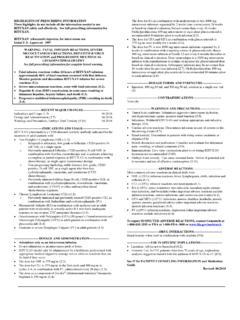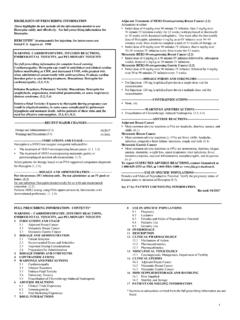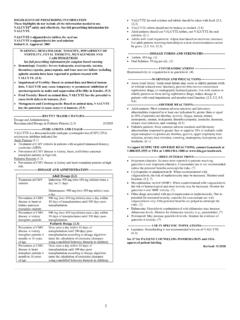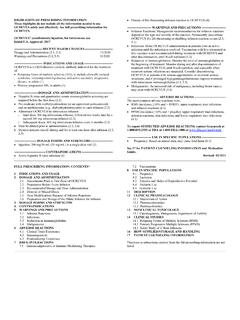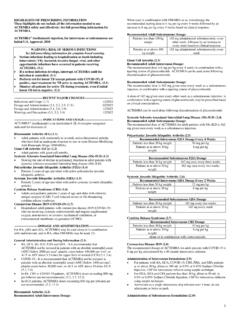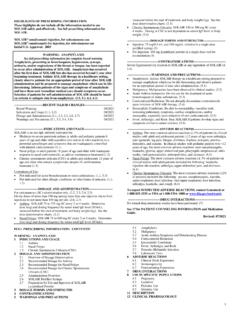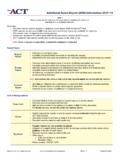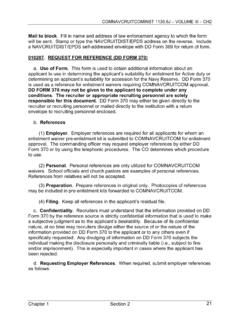Transcription of Reference ID: 4212951 - Genentech
1 1 HIGHLIGHTS OF PRESCRIBING information These highlights do not include all the information needed to use COTELLIC safely and effectively. See full prescribing information for COTELLIC. COTELLIC (cobimetinib) tablets, for oral use Initial Approval: 2015 --------------------------- INDICATIONS AND USAGE ---------------------------- COTELLIC is a kinase inhibitor indicated for the treatment of patients with unresectable or metastatic melanoma with a BRAF V600E or V600K mutation, in combination with vemurafenib. (1, 14) ----------------------- DOSAGE AND ADMINISTRATION ----------------------- Confirm the presence of BRAF V600E or V600K mutation in tumor specimens prior to initiation of COTELLIC. ( ) The recommended dose is 60 mg orally once daily for the first 21 days of each 28-day cycle until disease progression or unacceptable toxicity. Take COTELLIC with or without food. ( ) --------------------- DOSAGE FORMS AND STRENGTHS ---------------------- Tablets: 20 mg (3) ------------------------------ CONTRAINDICATIONS ------------------------------ None.
2 (4) ----------------------- WARNINGS AND PRECAUTIONS ------------------------ New primary malignancies, cutaneous and non-cutaneous: Monitor patients for new malignancies prior to initiation of therapy, while on therapy, and for up to 6 months following the last dose of COTELLIC. ( ) Hemorrhage: Major hemorrhagic events can occur with COTELLIC. Monitor for signs and symptoms of bleeding. ( , ) Cardiomyopathy: The risk of cardiomyopathy is increased in patients receiving COTELLIC with vemurafenib compared with vemurafenib as a single agent. The safety of COTELLIC has not been established in patients with decreased left ventricular ejection fraction (LVEF). Evaluate LVEF before treatment, after one month of treatment, then every 3 months thereafter during treatment with COTELLIC. ( , ) Severe Dermatologic Reactions: Monitor for severe skin rashes. Interrupt, reduce, or discontinue COTELLIC. ( , ) Serous Retinopathy and Retinal Vein Occlusion: Perform an ophthalmological evaluation at regular intervals and for any visual disturbances.
3 Permanently discontinue COTELLIC for retinal vein occlusion (RVO). ( , ) Hepatotoxicity: Monitor liver laboratory tests during treatment and as clinically indicated. ( , ) Rhabdomyolysis: Monitor creatine phosphokinase periodically and as clinically indicated for signs and symptoms of rhabdomyolysis. ( , ) Severe Photosensitivity: Advise patients to avoid sun exposure. ( , ) Embryo-Fetal Toxicity: Can cause fetal harm. Advise females of reproductive potential of the potential risk to a fetus and to use effective contraception. ( , , ) ------------------------------ ADVERSE REACTIONS ------------------------------ Most common adverse reactions for COTELLIC ( 20%) are diarrhea, photosensitivity reaction, nausea, pyrexia, and vomiting. The most common ( 5%) Grade 3-4 laboratory abnormalities are increased GGT, increased CPK, hypophosphatemia, increased ALT, lymphopenia, increased AST, increased alkaline phosphatase, hyponatremia. ( ) To report SUSPECTED ADVERSE REACTIONS, contact Genentech at 1-888-835-2555 or FDA at 1-800-FDA-1088 or ------------------------------ DRUG INTERACTIONS---------------------------- --- Avoid concomitant administration of COTELLIC with strong or moderate CYP3A inducers or inhibitors.
4 ( , , ) ----------------------- USE IN SPECIFIC POPULATIONS ----------------------- Lactation: Do not breastfeed while taking COTELLIC. ( ) See 17 for PATIENT COUNSELING information and FDA-approved patient labeling. Revised: 01/2018 _____ FULL PRESCRIBING information : CONTENTS* 1 INDICATIONS AND USAGE 2 DOSAGE AND ADMINISTRATION Patient Selection Recommended Dose Dose Modifications 3 DOSAGE FORMS AND STRENGTHS 4 CONTRAINDICATIONS 5 WARNINGS AND PRECAUTIONS New Primary Malignancies Hemorrhage Cardiomyopathy Severe Dermatologic Reactions Serous Retinopathy and Retinal Vein Occlusion Hepatotoxicity Rhabdomyolysis Severe Photosensitivity Embryo-Fetal Toxicity 6 ADVERSE REACTIONS Clinical Trials Experience 7 DRUG INTERACTIONS Effect of Strong or Moderate CYP3A Inhibitors on Cobimetinib Effect of Strong or Moderate CYP3A Inducers on Cobimetinib 8 USE IN SPECIFIC POPULATIONS Pregnancy Lactation Females and Males of Reproductive Potential Pediatric Use Geriatric Use Hepatic Impairment Renal Impairment 10 OVERDOSAGE 11 DESCRIPTION 12 CLINICAL PHARMACOLOGY Mechanism of Action Pharmacodynamics Pharmacokinetics 13 NONCLINICAL TOXICOLOGY Carcinogenesis, Mutagenesis.
5 Impairment of Fertility 14 CLINICAL STUDIES 16 HOW SUPPLIED/STORAGE AND HANDLING 17 PATIENT COUNSELING information *Sections or subsections omitted from the full prescribing information are not listed _____ Reference ID: 42129512 FULL PRESCRIBING information 1 INDICATIONS AND USAGE COTELLIC is indicated for the treatment of patients with unresectable or metastatic melanoma with a BRAF V600E or V600K mutation, in combination with vemurafenib. 2 DOSAGE AND ADMINISTRATION Patient Selection Confirm the presence of BRAF V600E or V600K mutation in tumor specimens prior to initiation of treatment with COTELLIC with vemurafenib. information on FDA-approved tests for the detection of BRAF V600 mutations in melanoma is available at: Recommended Dose The recommended dosage regimen of COTELLIC is 60 mg (three 20 mg tablets) orally taken once daily for the first 21 days of each 28-day cycle until disease progression or unacceptable toxicity [see Clinical Studies (14)].
6 Take COTELLIC with or without food [see Clinical Pharmacology ( )]. If a dose of COTELLIC is missed or if vomiting occurs when the dose is taken, resume dosing with the next scheduled dose. Dose Modifications Concurrent CYP3A Inhibitors Do not take strong or moderate CYP3A inhibitors while taking COTELLIC. If concurrent short term (14 days or less) use of moderate CYP3A inhibitors is unavoidable for patients who are taking COTELLIC 60 mg, reduce COTELLIC dose to 20 mg. After discontinuation of a moderate CYP3A inhibitor, resume previous dose of COTELLIC 60 mg [see Drug Interactions ( ) and Clinical Pharmacology ( )]. Use an alternative to a strong or moderate CYP3A inhibitor in patients who are taking a reduced dose of COTELLIC (40 or 20 mg daily) [see Drug Interactions ( ) and Clinical Pharmacology ( )]. Adverse Reactions Review the Full Prescribing information for vemurafenib for recommended dose modifications. Table 1. Recommended Dose Reductions for COTELLIC First Dose Reduction 40 mg orally once daily Second Dose Reduction 20 mg orally once daily Subsequent Modification Permanently discontinue COTELLIC if unable to tolerate 20 mg orally once daily Reference ID: 42129513 Table 2.
7 Recommended Dose Modifications for COTELLIC for Adverse Reactions Severity of Adverse Reactiona Dose Modification for COTELLIC New Primary Malignancies (cutaneous and non-cutaneous) No dose modification is required. Hemorrhage Grade 3 Withhold COTELLIC for up to 4 weeks. If improved to Grade 0 or 1, resume at the next lower dose level. If not improved within 4 weeks, permanently discontinue. Grade 4 Permanently discontinue. Cardiomyopathy Asymptomatic, absolute decrease in LVEF from baseline of greater than 10% and less than institutional lower limit of normal (LLN) Withhold COTELLIC for 2 weeks; repeat LVEF. Resume at next lower dose if all of the following are present LVEF is at or above LLN and Absolute decrease from baseline LVEF is 10% or less. Permanently discontinue if any of the following are present LVEF is less than LLN or Absolute decrease from baseline LVEF is more than 10%. Symptomatic LVEF decrease from baseline Withhold COTELLIC for up to 4 weeks, repeat LVEF.
8 Resume at next lower dose if all of the following are present: Symptoms resolve and LVEF is at or above LLN and Absolute decrease from baseline LVEF is 10% or less. Permanently discontinue if any of the following are present Symptoms persist, or LVEF is less than LLN, or Absolute decrease from baseline LVEF is more than 10%. Dermatologic Reactions Grade 2 (intolerable), Grade 3 or 4 Withhold or reduce Retinopathy or Retinal Vein OcclusionSerous retinopathy Withhold COTELLIC for up to 4 weeks. If signs and symptoms improve, resume at the next lower dose level. If not improved or symptoms recur at the lower dose within 4 weeks, permanently vein occlusion Permanently discontinue COTELLIC. Reference ID: 42129514 Severity of Adverse Reactiona Dose Modification for COTELLIC Liver Laboratory Abnormalities and Hepatotoxicity First occurrence Grade 4 Withhold COTELLIC for up to 4 weeks. If improved to Grade 0 or 1, then resume at the next lower dose level. If not improved to Grade 0 or 1 within 4 weeks, permanently discontinue.
9 Recurrent Grade 4 Permanently discontinue COTELLIC. Rhabdomyolysis and Creatine Phosphokinase (CPK) elevations Grade 4 CPK elevation Any CPK elevation and myalgia Withhold COTELLIC for up to 4 weeks. If improved to Grade 3 or lower, resume at the next lower dose level. If not improved within 4 weeks, permanently discontinue. Photosensitivity Grade 2 (intolerable), Grade 3 or Grade 4 Withhold COTELLIC for up to 4 weeks. If improved to Grade 0 or 1, resume at the next lower dose level. If not improved within 4 weeks, permanently discontinue. Other Grade 2 (intolerable) adverse reactions Any Grade 3 adverse reactions Withhold COTELLIC for up to 4 weeks. If improved to Grade 0 or 1, resume at the next lower dose level. If not improved within 4 weeks, permanently discontinue. First occurrence of any Grade 4 adverse reaction Withhold COTELLIC until adverse reaction improves to Grade 0 or 1. Then resume at the next lower dose level, OR Permanently discontinue.
10 Recurrent Grade 4 adverse reaction Permanently discontinue COTELLIC. a National Cancer Institute Common Terminology Criteria for Adverse Events version (NCI CTCAE ) 3 DOSAGE FORMS AND STRENGTHS Tablets: 20 mg, white, round, film-coated, debossed on one side with COB . 4 CONTRAINDICATIONS None. 5 WARNINGS AND PRECAUTIONS Review the Full Prescribing information for vemurafenib for information on the serious risks of vemurafenib. New Primary Malignancies New primary malignancies, cutaneous and non-cutaneous, can occur with COTELLIC. Cutaneous Malignancies: In Trial 1, the following cutaneous malignancies or premalignant conditions occurred in the COTELLIC with vemurafenib arm and the vemurafenib arm, respectively: cutaneous squamous cell carcinoma (cuSCC) or keratoacanthoma (KA) (6% and 20%), basal cell carcinoma ( and ), and second primary melanoma ( and ). Among patients receiving COTELLIC with vemurafenib, the median time to detection of first cuSCC/KA was 4 months (range: 2 to 11 months), and the median time to detection of basal cell carcinoma was 4 months (range: 27 days to 13 months).

